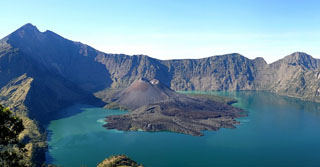Report on Rinjani (Indonesia) — 25 November-1 December 2015
Smithsonian Institution / US Geological Survey
Weekly Volcanic Activity Report, 25 November-1 December 2015
Managing Editor: Sally Sennert.
Please cite this report as:
Global Volcanism Program, 2015. Report on Rinjani (Indonesia) (Sennert, S, ed.). Weekly Volcanic Activity Report, 25 November-1 December 2015. Smithsonian Institution and US Geological Survey.
Rinjani
Indonesia
8.42°S, 116.47°E; summit elev. 3726 m
All times are local (unless otherwise noted)
Based on satellite and ground observations, the Darwin VAAC reported that during 24-30 November ash plumes from Rinjani rose to altitudes of 3.7-4.3 km (12,000-14,000 ft) a.s.l. and drifted as far as 320 km SW and W.
Geological Summary. Rinjani volcano on the island of Lombok rises to 3726 m, second in height among Indonesian volcanoes only to Sumatra's Kerinci volcano. Rinjani has a steep-sided conical profile when viewed from the east, but the west side of the compound volcano is truncated by the 6 x 8.5 km, oval-shaped Segara Anak (Samalas) caldera. The caldera formed during one of the largest Holocene eruptions globally in 1257 CE, which truncated Samalas stratovolcano. The western half of the caldera contains a 230-m-deep lake whose crescentic form results from growth of the post-caldera cone Barujari at the east end of the caldera. Historical eruptions dating back to 1847 have been restricted to Barujari cone and consist of moderate explosive activity and occasional lava flows that have entered Segara Anak lake.

